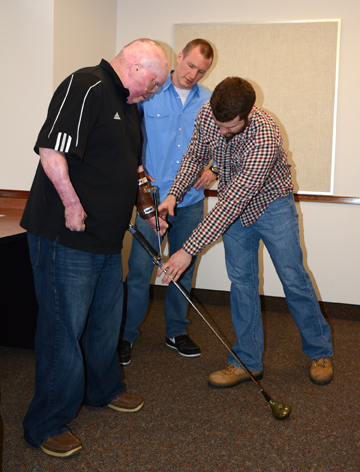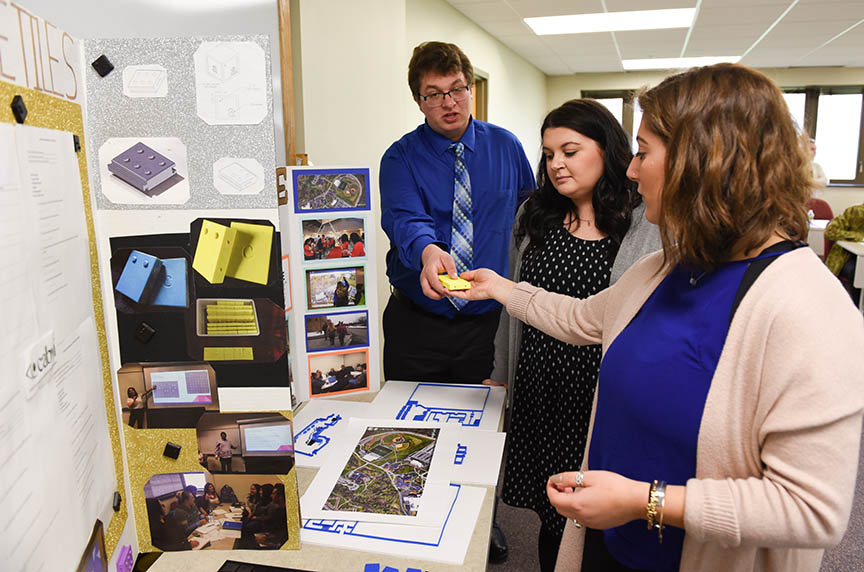
The culture at SUNY Poly is marked by interdisciplinary innovation toward practical solutions to real-world problems. A shining example is the work being done by those involved in humanitarian engineering initiatives across campus. As part of these efforts, faculty members from all four SUNY Poly colleges are collaborating to develop solutions that will change lives.
The SUNY Poly Stories team spoke with four of these faculty members – one from each college – to discuss these exciting initiatives and how this interdisciplinary work happens.
SUNY Poly Stories
What exactly is humanitarian engineering and how did it get its start at SUNY Poly?
Dr. Joanne Joseph
Humanitarian engineering is exactly what it sounds like – engineering solutions driven by humanitarian issues. These efforts began at SUNY Poly about twelve years ago when I was working with military veterans. One of the other consultants was a veteran who was badly injured in an IED blast. He spent three years in a burn unit at Fort Hood recovering and ended up with several permanent injuries. Yet, he went on to help so many other veterans.

One day I asked him if there was one activity he particularly wished he could return to and he told me how much he missed golfing. A few of us looked for a product that could help him but couldn’t find any options.
It occurred to me to go to the engineering department at SUNY Poly and, sure enough, two students took on designing an adaptive golf club. They were able to develop a solution for him using 3D printing that cost less than $300 to produce – and it got this wonderful man back to golfing. It all developed into such a special relationship and had such an important impact. It really showed us all the life-changing potential of programs like these.
SUNY Poly Stories
Can you tell us more about how humanitarian engineering has grown?
Dr. Joanne Joseph
Since that first project, the humanitarian engineering efforts at SUNY Poly have proliferated. We now have Humanitarian Engineering and Humanitarian Studies minors and research and development are happening constantly. We’ve been involved in a number of projects with community partners like the Sitrin Health Care Center, the Central Association for the Blind and Visually Impaired, United Cerebral Palsy, and the Central New York Home Health Network. Our faculty and students have developed blocks to help teach braille, enhancements to wheelchairs, prosthetics to enable computer access, and various adaptive sports equipment. The more we accomplish, the more we realize the potential of how much more there is we could achieve together.

Mechanical Engineering Technology students created Braille titles as part of a project-based learning assignment for Community and Behavioral Health (CBH).
SUNY Poly Stories
Dr. Boylan, you have been involved in several of these projects. How did you become involved?
Dr. Kristina Boylan
Dr. Joanne Joseph has been a mentor and friend to me since I came to SUNY Poly in 2002. Her passion for integrating academic work with community engagement has always been inspiring. It didn’t take long for me to start asking how I could connect my work to that goal. Dr. Joseph invited me into several collaborations in the mid-2010s. And, as she and a group of us worked to establish the Humanitarian Engineering and Humanitarian Studies minors, that group slowly evolved into a larger collaboration that now exists among many members of campus.
SUNY Poly Stories
Can you talk a little more about how that interdisciplinary evolution has impacted your work?
Dr. Kristina Boylan
My academic work in social history and interest in the visual arts led me to think critically about shortfalls in visually-oriented presentations of scholarly work and in creative assignments that could have the potential to exclude students with disabilities from full participation and collaboration with their peers. However, as a historian and avocational visual artist, I knew I did not have the knowledge or training to work with assistive technologies, and so I knew I would need to find ways to collaborate with others to find or develop solutions to these problems.
As support for research initiatives across the campus emerged in recent years, I had conversations with colleagues like Dr. Jiayue Shen and Dr. Ana Jofre about developing some solutions for improving learning experiences and technologies that explicitly or implicitly exclude blind or visually impaired users. Working with these colleagues has truly energized my work and inspired so many collaborative projects.
SUNY Poly Stories
Can you talk more specifically about a recent project?
Dr. Kristina Boylan
Sure! In 2023, I coordinated a funding proposal and received an Innovative Instructional Technology Grant, along with Dr. Ana Jofre, Dr. Jiayue Shen, and Dr. Dan Jones. Our project seeks to make affordable solutions available – using existing technology – to ensure that people who are blind or visually impaired are able to fully participate during activities that are visually oriented, like poster sessions, art exhibits, and digital media.
There are two major parts of our work this academic year. The first is collaborating with the Central Association for the Blind and Visually Impaired to create an accessible website with information for assistive technology users and the people who support them, helping them to understand devices that are available, how and when to use them, and how to improve the user experience.
The second part involves using the SUNY Poly Gannett Gallery as an educational space to find technologically accessible and affordable ways to enhance visual displays. A range of technologies already exist, such as refreshable Braille readers, tactile maps of exhibition spaces, devices for listening and screen-reading, etc. However, as our research project is revealing, many do not work well together without quite a bit of planning and coordination! The CCAVA team wants to simplify this process by publishing guides on our website with “do-it-yourself” methods for creating more accessible exhibits, for use by educators, students, artists, gallerists, and others.
SUNY Poly Stories
What a fantastic project! Dr. Shen, in addition to this CCAVA project, you have been principal investigator on several projects for which you’ve won grants, including some focused on humanitarian engineering. Can you talk a bit about those projects?
Dr. Jiayue (Joyce) Shen
My work primarily focuses on flexible electronics, and I’m involved in a number of interdisciplinary projects related to this right now. The first is developing a 3D-printed wearable sensor that measures arterial pulse waveforms. The goal is to make a more accurate and cost-effective health monitoring system which can hopefully play a role in detecting issues in those with various cardiovascular diseases.
My colleagues and I also recently submitted a proposal to add on to this project. We are hoping to measure more signals, particularly electrodermal activity (EDA), or skin surface signals, which are considered in applications related to a variety of physiological phenomena, from stress to epilepsy to neuropathy. I’m collaborating with an electrical engineer who has a sensor that can measure the EDA signals and I’m going to fabricate the conductive electronics for him. The challenge is that it needs to cover a large enough part of the skin’s surface to get an accurate reading – we’ve proposed a wristband but may decide to expand it to a glove.
SUNY Poly Stories
It sounds like these projects have major potential to improve people’s health and lives. Is all of your work biomedically focused?
Dr. Jiayue (Joyce) Shen
No. Another project I’m currently working on is an IoT-based pavement monitoring system. This project is to help people who work in the Department of Transportation collect road condition-related data without traveling from their office. This will save costs and, more importantly, reduce the accidents happening among the DOT staff, while allowing them to continually monitor the health of the roads and improve traffic safety.
I’m also collaborating with colleagues from civil engineering, mechanical engineering, and our interactive media program to develop a virtual reality module to help engineering students learn mechanics within the classroom. This method will help to get a more visualized sense of how forces are distributed within civil structures. Once complete, this will be distributed to the whole SUNY campus.
SUNY Poly Stories
It sounds like you and your colleagues have no shortage of ideas to work on!
Dr. Jiayue (Joyce) Shen
We are lucky to have such an interdisciplinary culture at SUNY Poly. The campus is small, so I can potentially end up talking to anyone from any area and I always feel like I can just knock on a door or approach someone at an event. Ideas spread easily.
SUNY Poly Stories
Would you say that this interdisciplinary approach happens naturally or do academic leaders orchestrate opportunities where they are more likely to occur?
Dr. Jiayue (Joyce) Shen
For the most part naturally. Dr. Joseph established an interdisciplinary humanitarian engineering group to meet up and share ideas; eventually it became much more open as we sought out more areas of expertise and brought more people into the fold. This has been a great thing. With so many disciplines coming together, it creates more possibilities and solutions for existing problems in the world. It also makes for more competitive funding applications.
SUNY Poly Stories
It sounds like this culture is producing incredible projects that will improve the daily lives of many people. Dr. Joseph: once SUNY Poly researchers discover a new method, device, or knowledge that can help people struggling with a specific issue, what’s next?
Dr. Joanne Joseph
Once these solutions are developed, implementing them by connecting them with people is the next step! We are working with our talented partners in the business school to plan for this, particularly Dr. Katie Matt.
SUNY Poly Stories
Dr. Matt, can you tell us about the role you will be playing in these efforts?
Dr. Katie Matt
Yes! I am looking forward to being a part of these initiatives by helping with business planning and marketing. It will be important to have a marketing strategy in place to share the great work the team is doing, connecting these projects with the larger community and beyond, and bringing their solutions to the people who need them most. I am excited to be able to contribute to making people aware of the great humanitarian work being done here across disciplines at SUNY Poly.
About Humanitarian Studies and Humanitarian Engineering at SUNY Poly
The Humanitarian Studies (HS) and Humanitarian Engineering (HE) minors are unique curricula that combine multidisciplinary approaches to solve real-world problems for people right in our local community. Students can come into the minors from a variety of backgrounds and will work with local community agencies to develop assistive technologies that help individuals in their daily lives.